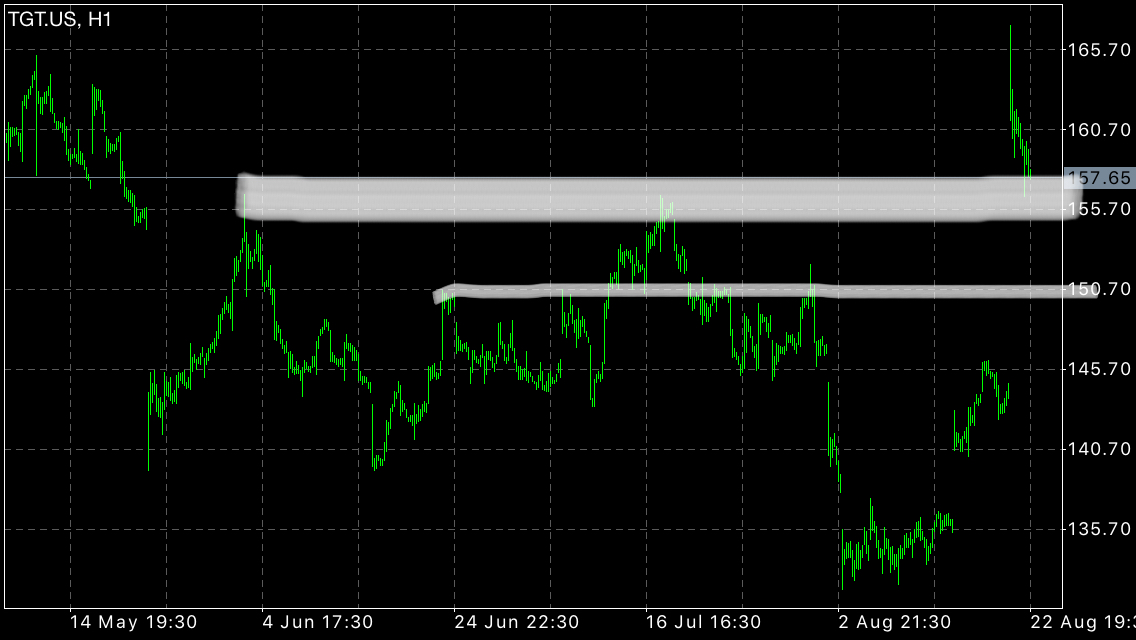Last Spikes in Target Share Price
The first time when I brought my humble attention to Target stock was my birthday party. My brother-in-law presented a T-shirt with a painting of a white bear and a star in the sky above the beast, accompanied by a “Golden State California” pride slogan. It still serves me to symbolize a cheap style of sweet home comfort, but also perfect resilience to all kinds of winds, for more than 18 months. When asked where he got this piece of simple beauty, he said his sister just sent a package with “made in USA” gifts, and this particular thing was purchased for $19.99 in some store named Target.
I was curious enough to google and tried to find out what this Target is. Various sources described it as probably the second largest chain of stores in the middle between the consumer discretionary and the discount segment of North American retailers. As an investor, I became immediately intrigued by a self-imposed investigation why Target stock was not a part of my portfolio to join successful Walmart and Lowe’s or a problematic but recovering Macy’s, and I quickly found a solid reason with its clearly troubled price dynamics. It happened so that Target was so shining investment to gain as much as possible in the corona time. However, in 2022 and 2023, it has been “weighted, measured and found wanting”, if you know what I mean.
The overvalued stock ultimately dropped from above $250 to nearly $100, and it was abandoned there for many months, as Target’s profit margin was squeezed between Scylla of elevated supply chain expenses and Charybdis of cost-conscious consumers. Thus, I almost abandoned any plans of investing some of my free cash into Target, but now it looks like an advantageous time to revisit the idea.
Target stock is soaring now. Supported by strong Q2 results, it spiked from nearly $145 to $167.20 at a short-lived intraday peak on August 21. The price retraced to a little more adequate range between $157 and $160, and so it can be called attractive, as it is less than 10% higher on solid fundamentals, also offering a nearly 10% discount against its newly minted, and hopefully temporary peaks.
Financial performance of Target did not decline in July, with both June and July were stronger than May, based on promotional activities and strategic planning, its CEOs commented after the chain announced quarterly earnings per share of $2.57 on sales of $25.45 bln vs $2.19 on $25.2 bln in consensus bets of Wall Street analysts, after $2.03 on $24.5 bln in Q1 and $1.8 of EPS on $24.8 in the same season of 2023, with comparable sales rising by 2% YoY.
And, what is more important, I am not alone in my current investment desires. UBS adjusted its outlook on Target by raising its price target to $200 from the previous $185 and keeping a Buy rating on the stock, citing “a surge in customer traffic, robust gross margin improvements, and an uptick in other income, attributed partly to a double-digit increase in advertising revenue”. Meanwhile, the Bank of America raised its price target to $195, which belongs to almost the same technical area. Target’s estimated EPS for the fiscal year of 2025 has been shifted from $9.45 to $9.70. A rather pessimistic RBC Capital also increased its price target for Target from $174 to $177, with an Outperform rating and potential revenue growth of 0.4% and 1.5% for fiscal years 2024 and 2025, respectively. Wells Fargo revised its target to $180 from $160, which is not so bad as well. Evercore ISI raised its target for Target to $160 only, reflecting a global slowdown in the e-commerce sector, but saying that Target's EPS may approach $9.50 in 2024 and $10.50 in 2025.

Disclaimer:
The comments, insights, and reviews posted in this section are solely the opinions and perspectives of authors and do not represent the views or endorsements of RHC Investments or its administrators, except if explicitly indicated. RHC Investments provides a platform for users to share their thoughts on financial market news, investing strategies, and related topics. However, we do not guarantee the accuracy, completeness, or reliability of any user-generated content.
Investment Risks and Advice:
Please be aware that all investment decisions involve risks, and the information shared on metadoro.com should not be considered as financial advice. Always conduct thorough research, seek professional advice, and exercise caution when making investment decisions.
Moderation and Monitoring:
While we strive to maintain a respectful and informative environment, we cannot endorse or verify the accuracy of all user-generated content. We reserve the right to moderate, edit, or remove any comments or posts that violate our community guidelines, infringe on intellectual property rights, or contain harmful content.
Content Ownership:
By submitting content to metadoro.com, users grant RHC Investments a non-exclusive, royalty-free license to use, display, and distribute the content. Users are responsible for ensuring they have the necessary rights to share the content they post.
Community Guidelines:
To maintain a positive and respectful community, users are expected to adhere to the community guidelines of Metadoro. Any content that is misleading, offensive, or violates applicable laws and regulations will be subject to moderation or removal.
Changes to Disclaimer:
We reserve the right to update, modify, or amend this disclaimer at any time. Users are encouraged to review this disclaimer periodically to stay informed about any changes.









